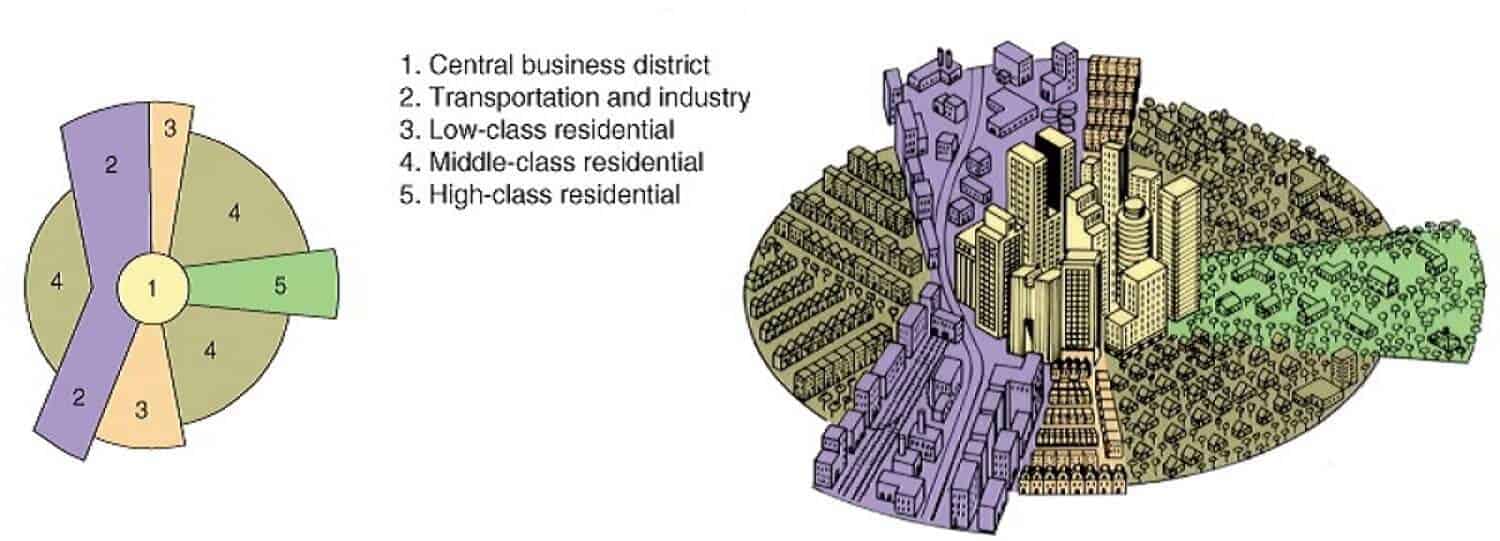
Hoyt model/Sector model of Urban Land Use (1939) by Homer Hoyt
Urban areas have always been an area of research and caught the attention of scholars and academicians. Homer Hoyt gave sector model which is also known as Hoyt model in 1939 explains how cities grew. As we witness the population growth it is becoming more and more essential to understand how cities work. Studies on patterns of urban growth, settlement geography, and land use are of great interest to the concerned people. Various theories and models have been proposed which attempts to explain how the growth took place and how different groups & activities are arranged in an urban area. Different models about the growth of urban regions include rank-size rule, primate city & primacy, central place theory, Multiple Nuclei Model, Burgess Model.
Hoyt Model is somewhat similar to Burgess Model and is often considered as its improved version. Hoyt argued that cities do not develop in the form of simple rings, instead, they have “sectors.” Homer Hoyt in 1939 suggested that few activities grow in the form of sectors which radiates out along the main travel links. Activities in a sector are considered to be the same throughout the sector because of the purpose/function it serves. Land use within each sector would remain the same because like attracts like. The high-class sector would stay high-class because it would be the most sought after area to live, so only the rich could afford to live there. The industrial sector would remain industrial as the area would have a typical advantage of a railway line or river. These sectors can be housing, industrial activities, etc. These sectors grow along railway lines, highways or rivers.
Components of Hoyt Model
CBD – Central Business District is placed at the center. Sectors and the partial rings of land use/activities take place. This area is often known as downtown and has high rise buildings.
Industry – Industries are represented in the form of a sector radiating out from the center. These forms sector because of the presence of a transport linkage along which the activities grew. Presence of railway line, river or road would attract similar activity, and thus a continuous corridor or “sector” will develop.

Apart from the industries this area also serves as a residential area for lower class workers. Living conditions are bad because of proximity to industries.
Low-Class Residential
Low-income groups reside in this area. Narrow roads, high population density, small houses with poor ventilation exist in this area. Roads are narrow and often connects to the industries where most of the people in this sector work. Closeness to industries reduces the travel cost and thus attracts industrial workers. Environmental and living conditions are often inadequate because of the proximity to factories.
Middle-Class Residential
This area has middle income groups who can afford more substantial travel cost and want better living conditions. The activities of people residing in this area consist of different activities and not just the industrial work. It has more linkages with CBD along with some linkages to industries. This area has the most significant residential area.
High Class residential
This is the outermost and farthest area from the downtown. Wealthy and affluent people live in this area. This area is clean, has less traffic, quiet and has large houses. Corridor or spine extending from CBD to the edge has the best housing.
The significance of Hoyt Model
- Ecological factors + economic rent concept to explain the land use pattern
- Stress on the role of transport routes in affecting the spatial arrangement of the city
- Both the distance and direction of growth from the city center are considered
- Brings location of industrial and environmental amenity values as determinants in a residential place
- Example: Sectors of high-class residential areas tend to grow towards higher grounds, sites with a better view, more open space, the homes of influential leaders within the community and existing outlying, smaller settlements.
Limitations of Sector Model
- Only Railway lines are considered for the growth of sectors and do not make allowances for private cars.
- It is a monocentric representation of cities; multiple business centers are not accounted for in this model.
- Physical features – physical features may restrict or direct growth along specific wedges
- No reference to out of town development
Features of sector model
- Presence of low-income groups near industries supports Hoyt Model
- The Hoyt model realized that transportation (in particular) and access to resources caused a disruption of the Burgess model.
- Transport linkages profoundly influence activities and their locations. Low transportation cost and proximity to roads/railway reduce the cost of production.
- This model applies well to Chicago
- Account for major transportation routes and its effect on activities
